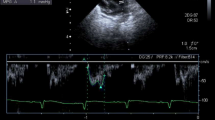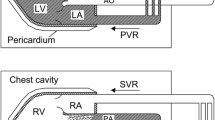Abstract.
Despite the increasing use of Doppler echocardiographic (DE) techniques to determine pulmonary arterial pressure in the neonate undergoing intensive care, there have been no studies comparing their repeatability in this population. Our objective was to compare the repeatability of four such techniques in neonates. The study was conducted in two regional neonatal units serving the North East of England. Group A (repeatability between observers): Two experienced observers performed detailed DE examinations, one directly after the other. Group B (within observer repeatability/temporal variability): One observer performed two examinations 1 hour apart. Group A comprised 15 preterm babies (26–36 weeks' gestation, 975–2915 g), most with mild respiratory failure; 4 healthy term babies; and 7 with congenital heart disease, in whom tricuspid regurgitation (TR) only was measured. Their ages were 18 hours to 12 days. Group B comprised 11 babies aged 12–64 hours with moderate to severe respiratory failure; 10 were preterm (26–36 weeks, 785–2800 g). We recorded four measurements: (1) Peak velocity of TR in m/s; (2) peak left-to-right ductal flow velocity (PDAmax in m/s); (3) TPV/RVET ratio; and (4) PEP/RVET ratio, where TPV = time to peak velocity at the pulmonary valve, PEP = right ventricular preejection period, and RVET = right ventricular ejection time. The Bland-Altman analysis was used to produce the coefficient of repeatability (CR: 95% confidence limits of repeatability), also expressed as a repeatability index (CR/mean value) and as a number of ``confidence steps''—a measure of sensitivity of the technique to hemodynamic change (range of values within the population/CR). Between-observer and within-observer repeatabilities were similar. Within-observer CR and index (%) results were for TR ± 0.26 m/s (9%); for PDAmax, ± 0.48 m/s (39%); TPV/RVET 0.1:1.0 (34%), PEP/RVET 0.12:1.00 (36%). TR and PDAmax had the largest number of confidence steps in the expected range of values (TR 8.5; PDA max 6.5; TPV/RVET 3.2; PEP/RVET 3.2). The most repeatable technique was TR, but PDAmax would also be useful for a serial study owing to the potential for large change. Systolic time interval ratios were less repeatable and likely to be less sensitive indicators of hemodynamic change.
Similar content being viewed by others
Author information
Authors and Affiliations
Rights and permissions
About this article
Cite this article
Skinner, J., Boys, R., Heads, A. et al. Estimation of Pulmonary Arterial Pressure in the Newborn: Study of the Repeatability of Four Doppler Echocardiographic Techniques. Pediatr Cardiol 17, 360–369 (1996). https://doi.org/10.1007/s002469900080
Issue Date:
DOI: https://doi.org/10.1007/s002469900080




